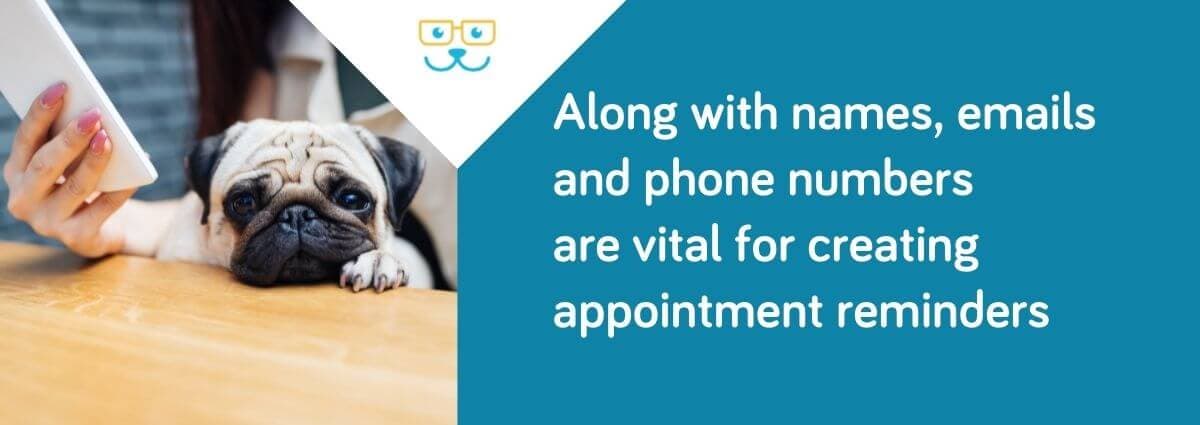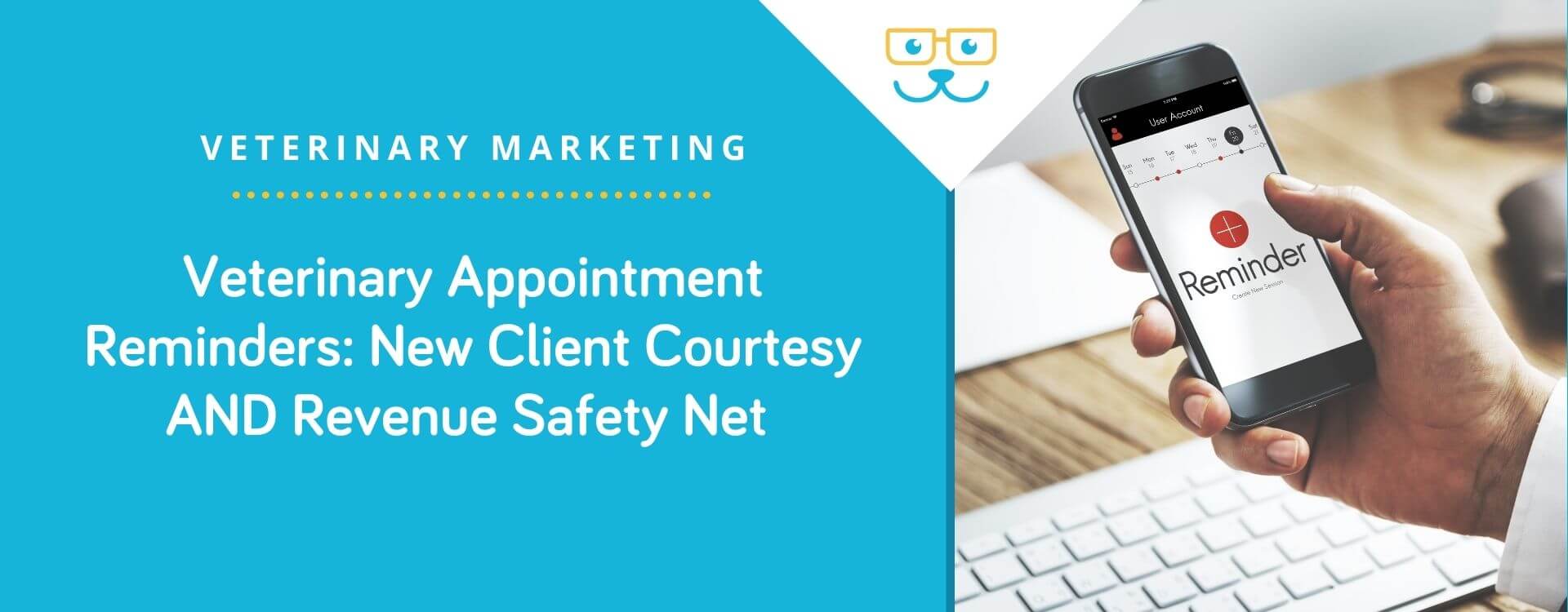Veterinary Appointment Reminders: New Client Courtesy AND Revenue Safety Net
It feels like a victory when a local pet owner chooses your veterinary practice to care for their beloved pet. Whether they respond to a friend's referral, a Pay-Per-Click ad, or an encounter with a staff member in your community, they decided to schedule an appointment with you, and you should celebrate acquiring a new client! But how committed is this pet owner to keeping that appointment? With every other commitment in people’s busy lives, how do you stay top of mind and ensure that this new client actually shows up -- and truly does become a client? Your appointment reminder system is vital to taming hectic schedules and forgetfulness and getting those new clients into your office.
The Little Things Can Be a Big Deal When Scheduling Appointments
The receptionist's telephone demeanor is the critical first component of scheduling a new client appointment. It cannot be over-emphasized: your staff must understand your practice culture and the importance of each potential client phone call. Because these phone calls are the lifeblood of your business, your staff must convey warmth and show the caller that this is a practice where people care. No matter how hectic the day, basic manners must be at the core of every phone call. Your receptionists should practice and plan ways to keep smiles on their faces during phone calls, even during those crazy, busy, stressful working days.
Receptionists must also convey the sense that this new client and patient will be seeing a fantastic doctor. Imagine that you are a pet owner, calling a doctor’s office for the first time ahead of then visiting for the first time. You feel confident enough to call for the appointment, but you still are unsure about what you’ll experience when you get there. The receptionist can boost that confidence by saying, "Oh my gosh, you will love Dr. Smith. She's just awesome. Everybody loves her, and she'll take great care of you."
Just that little extra sentence or two can really make someone feel comfortable that they've made a good choice. On this phone call, your staff member affirms their decision is a good one -- and it certainly will be obvious, even over the phone, that they genuinely believe this sentiment. Authenticity shines through and makes such a difference, especially with new clients.

Instill and reinforce these practices with regular training exercises. Then follow through by using your call tracking system to spot-check phone call recordings. Listen to one or two phone calls per receptionist per month, and even more calls, more frequently for your newest hires. Through these conversations, you’ll be able to tell whether they understand and convey your practice culture. This will also help you determine how to direct each receptionist’s next level of training. Compare these calls to your conversion numbers (the number of first-time callers who become new clients with scheduled appointments) to determine what statements and behaviors get new clients into your practice. Call recordings provide so much information about customer service and the growth of your practice that it is essential to listen to them regularly.
Details that Help Build Rapport and Build Reminders
Your receptionist should help personalize the phone call experience for each first-time caller as soon as possible. She should establish rapport early on by getting their name and their pet’s name. That way, during the phone conversation, she can refer back to their name. It’s easier to create a “center-of-attention” experience when a new client can hear, "Thanks so much for that information, Mrs. Johnson. We know you and Buster are going to love our practice!"
Part of adding this new patient to the appointment schedule is also setting up confirmations. If the appointment is more than 48 hours away, at this time, the receptionist should let the new client know that a reminder will be coming. You’ll need a phone number in the system to provide that reminder, which your staff will likely send via a confirmation call and/or text. For the pet owner, this is about thoughtfulness and convenience. You know they have a busy life, and your staff wants to provide a helpful reminder to keep their schedule on track. This is about ensuring that your doctors’ appointment calendars are full and revenue is steady for your business.

While it is nice to get an email on file, remember that your staff is already asking for a lot of information during this appointment scheduling phone call:
- Client name
- Pet’s name, species, age, and breed
- Phone number
- Email address
- Reason for visit
- Previous veterinarian
- Permission to get records
You may want to send out appointment confirmation emails, but the personal touch of a confirmation call may work to your benefit for this first visit. Therefore, you can feel comfortable collecting that email address and other information later when they are in the office and filling out new client welcome paperwork.
Online Requests Deserve Courtesy, Too
Often, when local pet owners remember that their pets need appointments, or even when they have time to schedule an appointment, it is not until the evening, and your office is closed. And, more and more frequently, when they pick up their phones to make veterinary appointments, they aren’t actually making a call. They are indeed on their phones, but they're looking at your mobile website rather than dialing your number. You can still gain those new appointments with an online appointment request form. Local pet owners need this convenience of a 24-hour method of reaching out to you.
Like during a phone call, you need to collect certain information from someone who requests an appointment online. It’s vital that your online appointment form:
- Asks, “Are you a new or existing client?”
- Asks new clients, “Were you referred by an existing client?” (you’ll want to know to thank that great client for the referral!)
- Contains a tracking pixel so you can accurately gauge how many users are landing on this form and completely filling it out. If you see many people landing on the page but abandoning the form, you may need to tweak the page.
Upon form completion, users should land on a Thank You page to confirm their form submission. Additionally, you should have a Confirmation Email sent to the user, providing their entered data back to them (i.e. -- all the completed information fields), as well as any additional information that your clinic needs to remind them of ("Your appointment will be confirmed by our staff via phone within 24 hours of this request," etc.).
These requests then deserve follow-up once your office opens again. Your reception staff should reply to them the next day to confirm the requests and the scheduled appointments. This same contact method can also be used for an appointment reminder 24 to 48 hours ahead, as appropriate.
The Appointment is Scheduled...But Is That Enough?
Besides their pets, your potential clients have families, careers, community obligations, and more competing for their attention and time. They’re busy! Particularly when appointments are made a week or more in advance, following up to confirm increases the chance that they will keep those appointments. If the pet owner has forgotten, you’ve helped them out.

You also have the chance to reinforce the positive associations that brought pet owners through the Awareness and Consideration stages into the Appointment stage of the Customer Journey. Your receptionists will remind them of the appointment date and time, plus let them know that your entire staff is looking forward to seeing them. Your practice is ready to meet their pet’s needs, and they can anticipate a great visit.
You appreciate reminders from your own health care providers, all the more when they are delivered in cheerful, friendly ways. In fact, we all tend to expect reminder systems to help us out! This is yet another way to demonstrate how much you value your clients and patients: appointment confirmations are part of stellar client service.
Health Care Services Can Also Help Build Reminders
Preventive and chronic care services present an additional and equally important form of reminders. These due dates become consistent nudges for pet owners to schedule repeated appointments and remain bonded to your practice. This starts with obtaining records from the previous veterinarian at the first appointment and is sustained as long as records are kept updated and accurate. Heartworm tests, vaccines, lab work, and medication refills are vital to patient health and your appointment calendar when you send texts, emails, or postcards to alert pet owners that services are due.
Again, you are asking for yet one more thing from your new client when you request previous veterinary records at the first visit, but in the long run, your staff will set up a reminder system to make the pet and pet owner’s lives easier. They’ll receive convenient reminders to maintain their pet’s best health, and of course, your practice will continue to generate revenue with each appointment.
Without confirming scheduled appointments, you’re simply hoping that local pet owners will remember to bring Fluffy to you at 2:00 pm next Wednesday. It’s not that they’re incapable of remembering their commitments, but there is no denying that we all seem to have a million things going on at any given time. Do your clients a favor by reminding them of their appointments with you. Those simple calls, texts, and emails go a long way to keeping their schedules, their pets’ health care, and your practice’s revenue all on track.
Are you looking for more evidence-based strategies for maintaining and growing your independent veterinary practice? Contact one of our Geniuses to get a Demo today!

